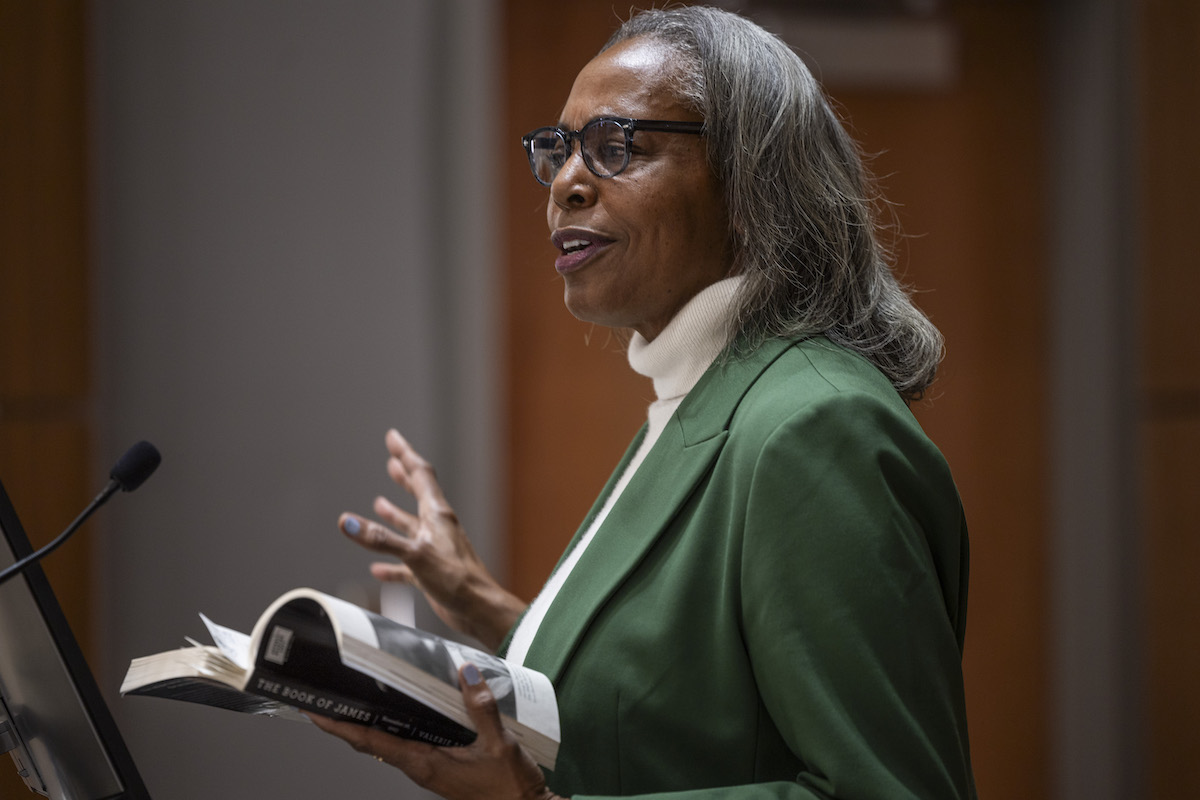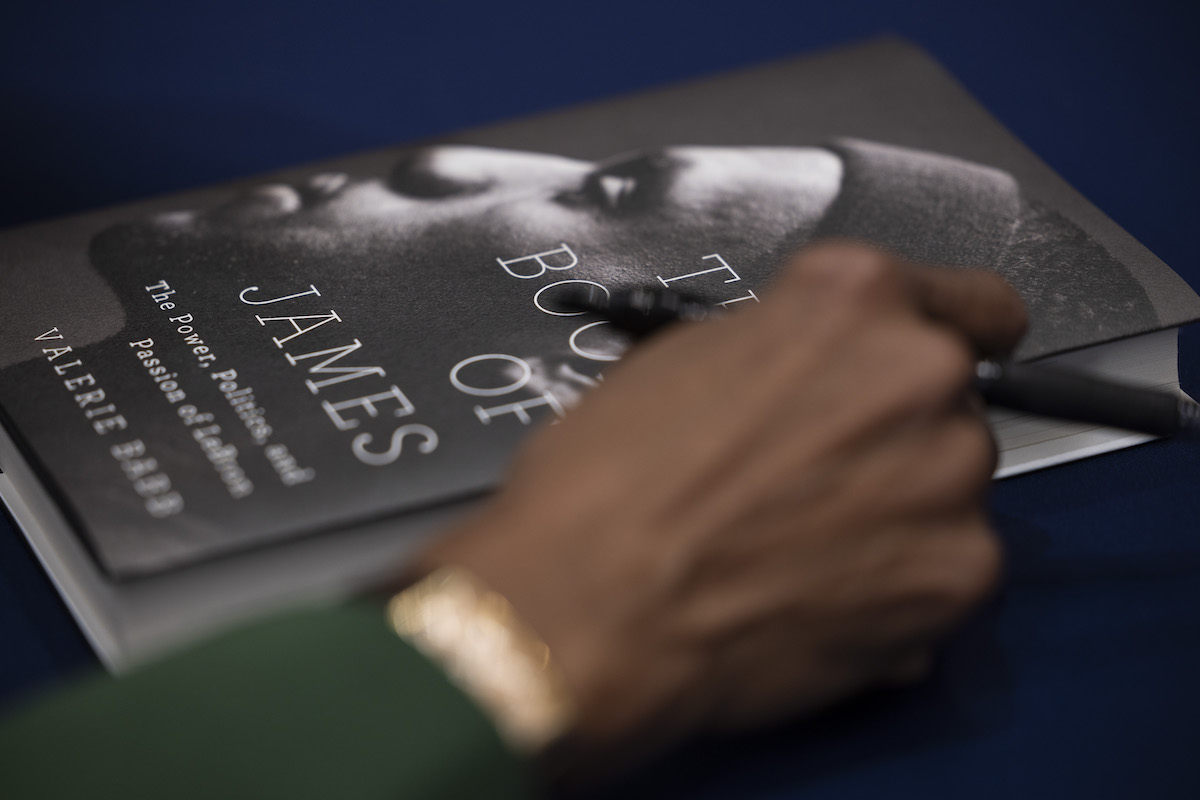“It is such an American story — poor Black boy from a ‘broken’ home in a poverty-stricken neighborhood makes good. Then, at the apex of his career, he finds the n-word spray painted across the gates of his home. LeBron James is the protagonist in both these American tales.”
That powerful summing up of the lived experience of one of the world’s most well-known athletes is the work of Valerie Babb, Emory’s Andrew Mellon Professor of Humanities, who gave a recent talk about her latest book, “The Book of James: The Power, Politics and Passion of LeBron.”
“One of these American tales is a success story that the nation loves because it shows its benevolence. The other is an installment in the ongoing expression of racial hatred,” Babb continues.
Holding joint appointments in African American Studies and English, Babb is the author of “A History of the African American Novel” and “Whiteness Visible: The Meaning of Whiteness in American Literature and Culture.” She co-authored “Black Georgetown Remembered,” developing a video by the same name. A scholar-in-residence at the Schomburg Center for Research in Black Culture, former editor of the Langston Hughes Review (2000-10) and a recipient of a W. M. Keck Foundation Fellowship in American Studies, Babb has lectured extensively in the United States and abroad.
And she loves the game of basketball.
However, as she joked to the audience, she gets shushed by family and friends for her running commentaries — some simply on the quality of play, some on the larger context of the stories being told. Fan and scholar, she has blended these passions into a unique book, one that sports journalist Mirin Fader calls “a wonderful companion to James’ legacy and an outright clinic on how to write about basketball, race, culture and America itself.”
Learning to shape the narrative
To Babb, James is not only what most of the world sees — the first billionaire working athlete — he is also skilled when it comes to narrative. Babb reports James saying, “I just got tired of people taking my soundbytes and using them the way they wanted to use them.”
In taking control of his own message, he has “stressed themes of Black ordinariness, not extremes one way or another but rather Black people just being,” according to Babb. Rather than trying to transcend Blackness, he models what she terms an “unapologetic Blackness” that gives the culture a position of prominence.
In this vein of showing the world the gifts of the ordinary people who have surrounded him since his earliest days, James has chosen his advisors well. He relies on a group of three childhood friends who, along with James, are known as the Four Horsemen: Rich Paul, James’ agent and founder of Klutch Sports; Randy Mims, James’ chief of staff; and Maverick Carter, CEO of SpringHill entertainment and Uninterrupted, both of which are responsible for the marketing and commercial side of James’ career.
For example, Paul — now one of the most successful agents in the NBA — did not attend college. To pay his bills, at one time he was selling sports jerseys out of the trunk of his car in Cleveland. James encountered Paul in a parking lot, bought a Magic Johnson jersey from him, and the rest is history.
One misstep early on regarding James’ image was his first appearance on the cover of Vogue magazine in 2008 with model Gisele Bundchen, which immediately prompted criticism and comparisons to King Kong and Fay Wray. Babb characterizes the message of that cover as “an old trope — defenseless white woman (and, by extension, white civilization) under threat from a Black ‘brute.’”
Babb finds the rationale that James offered for participating in that cover shoot to be “hollow,” but she concedes that “he was only five years out of high school and not yet educated in the full significance of what that image would mean to a larger public.”
His second appearance on Vogue’s cover in 2017 showed “he was learning,” notes Babb. Depicting him at home with his wife, Savannah, the article focuses on the couple’s work in James’ hometown of Akron, Ohio, and what they were building for the city: a reinvented public school and an extended network of community economic and health services. Readers learn that the LeBron James Family Foundation was turning away from being a “typical celebrity charity” into an organization of impact, working to increase the graduation rates of students from low-income families with low standardized test scores.
‘The Decision’
Two years after the Vogue cover, “The Decision” would find James at the heart of “another deep-rooted race narrative.” Even non-sports fans are familiar with The Decision, James’ choice to leave the Cleveland Cavaliers after seven seasons once he had become an unrestricted free agent.
In an ESPN primetime broadcast, James announced he would play for the Miami Heat. That event “became an unforeseen avatar of America’s peculiar institution” — provoking, in Babb’s words, “a new civil war between those who thought James a greedy, ungrateful athlete and those who knew he was the most underpaid athlete in the NBA.”
Public anger peaked with images of James’ Cavaliers jersey being burned. “It was difficult not to be reminded of what other things get burned in Black life — crosses, homes, successful business districts, human flesh itself,” says Babb.
As Babb chronicles in the book, when Cavaliers owner Dan Gilbert chided James for showing disrespect, the Rev. Jesse Jackson minced no words, saying: “[Gilbert’s] feelings of betrayal personify a slave-master mentality. He sees LeBron as a runaway slave … LeBron is not a child, nor is he bound to play on Gilbert’s plantation and be demeaned.”
In the wake of that decision, James made a Nike commercial directly addressing the competing claims on who he should be, at one point reading this excerpt from the Maya Angelou poem “Still I Rise”: “Shoot me with your words / You may cut me with your eyes / But still, like air, I rise.”
‘Mama, I made it’
Of all the “revisioning” James does of narratives that would misrepresent him, Babb is most fascinated with how he talks about his mother, Gloria James.
“Besides basketball, the thing James is most identified with is being the child of a single parent,” says Babb.
Gloria James had her son when she was 16 years old and raised him alone after her own mother died when LeBron was three, rendering the family’s economics even more uncertain. Mother and son moved seven times before LeBron was five years old, and he was temporarily sent to a foster family when his mother and her brothers couldn’t pay their heating bill.
Babb asserts that “James rewrote his early circumstances as an asset, forcing us to reevaluate what constitutes family.”
In a 2014 essay James authored for The Shriver Report, he writes: “She was my mother, my father, my everything. She put me first. I knew that no matter what happened, nothing and nobody was more important to her than I was.” With these words, James took the air out of the persistent trope of the lazy, nonworking single mother.
As Gloria James has aged, her community-activist role with the James Foundation and endearing photos in the media of her with her grandchildren have made her “more matron than project chick,” says Babb. But the greatest boost to her image remains her famous son, who never fails to signal her importance to him, including in the Miami Heat’s visit to the White House during Barack Obama’s term after winning the 2011-12 NBA championship. He ends his short remarks, clearly overwhelmed at the enormity of the visit, with the words, “Mama, I made it.”
Motherhood, in James’ world, continues to be celebrated, including the LeBron James Grandmothers’ Fan Club, founded in 2006 and consisting of, yes, grandmothers who do community work in Akron and have become local celebrities. They exulted when James brought a championship back to Cleveland in 2016 and enjoy the perks of being supporters of King James, as he is known. On the day of the championship parade in Cleveland, the bus the grandmothers were traveling on from Akron ran into barricades. When a police officer discovered who was aboard, the barricades were removed.
It seems an apt metaphor for how James has used his platform, “countering the myth that only certain people have the right to tell their story,” says Babb. “His stories leave a cultural record of how much Blackness is loved, hated, misunderstood and just plain cool in an America that has changed and not changed.”
Reserving a copy for the book’s subject
Asked in the Q&A whether James is aware of her book, Babb indicated she is pursuing that effort, recognizing the many twists and turns it will take to get to the man himself. Citing the main reason she undertook the project, Babb reveals, “LeBron has played the game as no one has played it before, with a kind of exuberance. The theoretical stuff, for me, came later.”
That last observation is a tongue-in-cheek reference to her book, which fellow faculty member Tayari Jones, Charles Howard Candler Professor of English and Creative Writing, describes as “bigger than LeBron and bigger than basketball. Be careful handling this work because Babb’s insights are so sharp that you might hurt yourself.”


